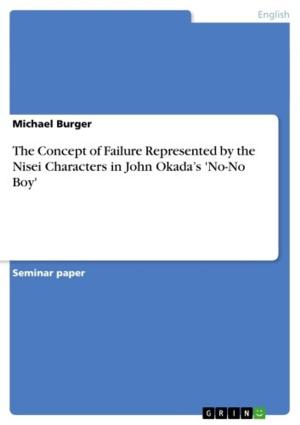The lessons to be learned from Peyton Farquhar - 'An Occurrence at Owl Creek Bridge' and its (anti)hero
'An Occurrence at Owl Creek Bridge' and its (anti)hero
Nonfiction, Entertainment, Drama, Anthologies| Author: | John Schulze | ISBN: | 9783638342667 |
| Publisher: | GRIN Publishing | Publication: | January 23, 2005 |
| Imprint: | GRIN Publishing | Language: | English |
| Author: | John Schulze |
| ISBN: | 9783638342667 |
| Publisher: | GRIN Publishing |
| Publication: | January 23, 2005 |
| Imprint: | GRIN Publishing |
| Language: | English |
Seminar paper from the year 2004 in the subject American Studies - Literature, grade: 1.0 (A), Humboldt-University of Berlin (Institute for Anglistics/American Studies), course: Fiction as Re-Construction of History: The Civil War in American Literature, 14 entries in the bibliography, language: English, abstract: His features were good-a straight nose, firm mouth, broad forehead, from which his long, dark hair was combed straight back, falling behind his ears to the collar of his well-fitting frock coat. He wore a mustache and pointed beard, but no whiskers; his eyes were large and dark gray, and had a kindly expression which one would hardly have expected in one whose neck was in the hemp. Evidently this was no vulgar assassin. The liberal military code makes provisions for hanging many kinds of persons, and gentlemen are not excluded. This is how Ambrose Bierce characterizes Peyton Farquhar, the Protagonist of his most well-known and celebrated short story, An Occurrence at Owl Creek Bridge. Here the reader is given various information about what kind of man is about to be hanged: he is handsome and has a kind air about him, he appears to be rather affluent, considering his 'well-fitting frock coat,' and he is no 'vulgar assassin.' Quite contrary, the sarcastic last sentence even hints that he is a gentleman. Among other things, this characterization is what lets Stuart C. Woodruff come to the conclusion that 'it is the tragic waste of such a man which engages our sympathies.' According to Woodruff, the assessment of Farquhar as a hero, deserving of the reader's sympathy, is vital to how and why the story works. Because its main character seems admirable, Woodruff calls Owl Creek Bridge a 'seemingly real tale of daring escape. Moreover, it is the kind of tale we would like to believe because Farquhar himself is such an attractive figure: brave, sensitive, highly intelligent.' Woodruff goes on calling him 'the typical Bierce hero' and in the end draws a familiar conclusion: Farquhar is Bierce and Bierce is Farquhar. According to Woodruff, Bierce, like the protagonist, longed 'for the release of his energies, the larger life of a soldier, the opportunity for distinction.' He became, like Farquhar, 'a civilian who was at heart a soldier.' This interpretation of Owl Creek is a common one, but nevertheless absolutely and completely wrong. Woodruff is mistaken when he assumes proximity between the story's author and main character. This misinterpretation can first and foremost be proven by Bierce's biography. For instance, Peyton Farquhar is a slave owner, as we learn in the story, but Bierce himself opposed slavery. Already at the age of fifteen he worked as a printer's devil at the abolitionist paper The Northern Indianan.
Seminar paper from the year 2004 in the subject American Studies - Literature, grade: 1.0 (A), Humboldt-University of Berlin (Institute for Anglistics/American Studies), course: Fiction as Re-Construction of History: The Civil War in American Literature, 14 entries in the bibliography, language: English, abstract: His features were good-a straight nose, firm mouth, broad forehead, from which his long, dark hair was combed straight back, falling behind his ears to the collar of his well-fitting frock coat. He wore a mustache and pointed beard, but no whiskers; his eyes were large and dark gray, and had a kindly expression which one would hardly have expected in one whose neck was in the hemp. Evidently this was no vulgar assassin. The liberal military code makes provisions for hanging many kinds of persons, and gentlemen are not excluded. This is how Ambrose Bierce characterizes Peyton Farquhar, the Protagonist of his most well-known and celebrated short story, An Occurrence at Owl Creek Bridge. Here the reader is given various information about what kind of man is about to be hanged: he is handsome and has a kind air about him, he appears to be rather affluent, considering his 'well-fitting frock coat,' and he is no 'vulgar assassin.' Quite contrary, the sarcastic last sentence even hints that he is a gentleman. Among other things, this characterization is what lets Stuart C. Woodruff come to the conclusion that 'it is the tragic waste of such a man which engages our sympathies.' According to Woodruff, the assessment of Farquhar as a hero, deserving of the reader's sympathy, is vital to how and why the story works. Because its main character seems admirable, Woodruff calls Owl Creek Bridge a 'seemingly real tale of daring escape. Moreover, it is the kind of tale we would like to believe because Farquhar himself is such an attractive figure: brave, sensitive, highly intelligent.' Woodruff goes on calling him 'the typical Bierce hero' and in the end draws a familiar conclusion: Farquhar is Bierce and Bierce is Farquhar. According to Woodruff, Bierce, like the protagonist, longed 'for the release of his energies, the larger life of a soldier, the opportunity for distinction.' He became, like Farquhar, 'a civilian who was at heart a soldier.' This interpretation of Owl Creek is a common one, but nevertheless absolutely and completely wrong. Woodruff is mistaken when he assumes proximity between the story's author and main character. This misinterpretation can first and foremost be proven by Bierce's biography. For instance, Peyton Farquhar is a slave owner, as we learn in the story, but Bierce himself opposed slavery. Already at the age of fifteen he worked as a printer's devil at the abolitionist paper The Northern Indianan.















